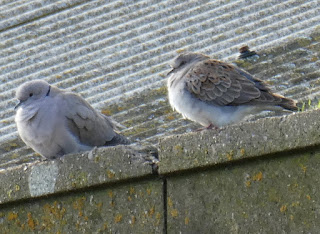Thursday 29th October was grey, windy and mizzley but with a Bairds Sandpiper, Little Stint and Curlew Sandpiper being reported at Dawlish Warren and a need to get out for the day I decided to tog up in my wet weather gear and head out there for a look.
High tide wasn't until around 5pm so I had a late start, arriving at Dawlish Warren at around 11:30 and I started off by weaving through the half term crowds to the sea wall for a scan offshore.
Viewing was difficult in the murk and large swell but a Great Northern Diver, a Red-throated Diver and a Great Crested Grebe were found close together close off the sea wall before all going their separate ways. The Red-throated Diver was very mobile and spent very little time at the surface between dives as it moved east along the shore before being lost from sight. In contrast the Great Northern Diver showed very well at the surface and was seen with a small flat fish which it struggled to get down its throat, it was some sort of ray or skate with a long tail but it eventually succeeded in getting it down.
A second Great Northern Diver was found further offshore and there may have been a second Red-throated Diver present too.
3 adult and a juvenile Gannet were picked up some distance offshore and the only other bird of note was a presumed White Wagtail feeding nearby on the grass by the sea wall.
I headed out along the dune ridge to Warren Point with a brief stop at the Main Pond along the way where a male Shoveler and a Little Grebe were seen. A Kestrel and a Skylark were the only birds of note at The Point while out on the water a very smart male Eider was watched diving before moving into the estuary and a Harbour (Common) Seal swam past into the estuary, quite close to the beach and unnoticed by walkers passing by.
Onwards to the hide ready for the incoming tide and both Dark-bellied and Pale-bellied Brent Geese were feeding on the eel grass out on the mudflats along with Wigeon, Teal, Shelduck, Oystercatcher, Curlew, Redshank, 2 Bar-tailed Godwit, Grey Plover, a Knot, Turnstone, Ringed Plover, 3 Greenshank, Dunlin, Little Egret, 2 Sanderling and a Grey Heron.
As the tide flowed in the small waders began to arrive in The Bight and eventually the Little Stint was found amongst them by local birder Lee, my first of the year. There was no sign of the Bairds Sandpiper but by this time the light was horrendous as twilight fell and it was wet and windy although a Curlew Sandpiper was found after I left.
A distant small wader was found out on its own, it looked unwell and was stood in water up to its chest, it eventually flew onto the mud where I lost track of it but local birder Ivan watched it being attacked and killed by a Carrion Crow which then flew off to eat it in the dunes. Another macabre sighting was a dead Short-eared Owl on the beach being pecked at by Carrion Crows.
A female type Merlin flew through spooking all the smaller birds out on the mudflats but it was unsuccessful and flew off towards Cockwood. A second calendar year Yellow-legged Gull was picked out by Lee amongst the roosting gulls, a very smart looking bird with a very pale head with dark eye mask, a large dark bill and a dark grey mantle and keeping itself aloofly apart from the other Gulls. A colour ringed Scandinavian Rock Pipit was seen feeding in The Bight before being chased off by an unringed Rock Pipit.
With the weather worsening, the light fading and the tide rising it was time to leave along the badly eroded beach before getting cut off by the rising tide and a Water Rail was heard squealing from the reeds around the Main Pond on the walk back to the cafe for a hot cup of tea before heading home.
A very enjoyable day out despite the poor light and weather, no Bairds Sandpiper but very pleased to see my first Little Stint of the year on quite a late date.
A summary of the day can be found here :-

























































